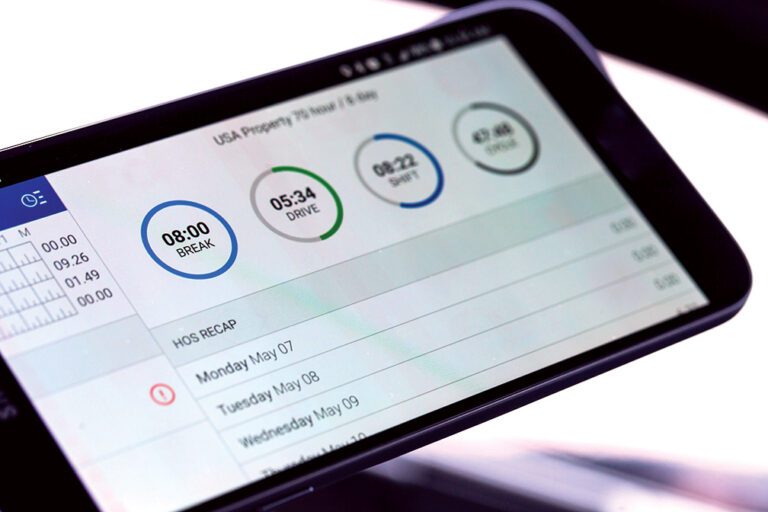Madison, Wisc. — Everyone can agree that hours-of-service (HOS) management is a critical aspect of all safety-sensitive operations. Fatigue has proven to be a top cause of all accidents involving a commercial motor vehicle.
Your truck’s electronic logging device (ELD) is the best tool available to capture HOS data and measure against the HOS minimums set forth by the Federal Motor Carrier Safety Administration (FMCSA) in a standardized format. These devices are relied on heavily in our industry to act as the de facto hours-of-service clock, referred to in audits, roadside inspections, and litigations.
The HOS rules are specific in writing and are expected to be followed. Because of this, ELD manufacturers build and implement logic and timetables into a recordable and presentable electronic device that your organization and law enforcement can access on demand.
There are many reasons utilizing an ELD is critical for business operations and meeting minimum regulations established by the U.S. Department of Transportation and FMCSA.
A false sense of security
But what if the ELD is not painting an actual picture of compliance or risk and instead is providing a false sense of security for your fleet? Are you depending on your ELD to manage your HOS, or are you an active participant in the process?
The intention of the ELD is to make it easier and faster to accurately track, manage and share HOS data, as well as create a safer working environment. While there is no doubt that tracking HOS data is much easier than it was with paper logs, that data still needs to be analyzed and managed by a safety professional.
According to the Compliance, Safety, Accountability (CSA) enforcement program, HOS violations in 2022 accounted for three of the Top 10 violations resulting in out-of-service (OOS) orders, including No Logs When Required (No. 2) and False Logs (No. 3). The top HOS violations include exceeding the 11- or 14-hour limits, not taking 10 hours off and false logs.
These statistics reveal that management is relying too heavily on ELDs and should start manually reviewing logs daily and hold their drivers accountable for following HOS rules.
Improved safety?
The question as to whether ELDs have improved safety as originally anticipated is hard to quantify because of factors such as the COVID-19 pandemic, which resulted in several HOS exceptions, as well as the HOS changes made in 2020.
However, if you look at the most recent data (October 2022) published by the FMCSA regarding crashes involving fatality or injury, it shows ELDs are not effective as “safety devices” on their own. Accident rates for “accidents by 100 million miles” have actually increased since the ELD mandate went into effect in 2017. In 2019, this figure actually increased 10% from 2016 — the year before the ELD mandate was enforced. This proves that relying strictly on ELD data is not an effective HOS management tool for your company or the public safety.
Considering the cost of implementing these devices, one would expect to have an ROI that can be pointed to, specific to reduction in accidents/injuries/fatalities, while also minimizing the workload on a motor carrier.
Unfortunately, this has proven to be the opposite of reality. Instead, an increase in accidents, risk and significant lawsuits have proliferated as indicated in the average size of verdicts since the ELD mandate went into effect. According to the American Transportation Research Institute’s (ATRI) Impact of Nuclear Verdicts study, fatigue and HOS were the No. 2 and No. 3 reasons by cases with a 95% success rate in verdicts. In many of these cases, the driver’s HOS were clearly in violation, and the motor carrier was found to be responsible and/or negligent.
Managing the data
With all the available data coming from your drivers’ ELDs, it can create the perception of negligence. How is your fleet managing the ELD output or reporting capabilities? What actions or trends are you as a motor carrier able to point to that ensures you’re not only employing safe hours of service practices but overall driver compliance and risk?
How a motor carrier manages their drivers’ ELD compliance — including reports, trends and data output — is critical to going beyond the minimum requirements while not falling victim to complacent compliance.
Consider these questions:
- Are you equipped to manage all elements of the FMCSA’s HOS compliance regulations without assistance?
- If an audit is called tomorrow, how confident are you that you’d receive a satisfactory rating?
- Would your feeling of confidence increase knowing you had a partner in compliance that has the experience and tools needed to provide support?
Fleetworthy Solutions has the tools to ingest information from your ELDs, identify trends and actionable data, and provide recommendations to improve your overall standing within the HOS Basic. A single source of truth, providing visibility 24/7/365 into your fleet and drivers is crucial to creating a safety net around your operations.
With Fleetworthy’s CPSuite, each driver’s HOS records are at your fingertips, along with the ability to manage other safety-regulated and risk-minimizing requirements such as DVIR/EVIR, maintenance records and driver qualification records.
Layering on Fleetworthy’s 40 years of industry experience, you’ll have an experienced team of subject matter experts (SMEs) available to you for all aspects of your fleet compliance. Our team of experts is adept at interpreting the information coming from all data sources, compiling it all into a single dashboard that provides a C-Suite level layout while also providing the details required for effective day-to-day fleet management. Having these resources at your disposal allows you to focus on the right areas and free up time to maintain the personal interaction needed with one of your most valuable resources — your drivers.
With Fleetworthy Solutions, you’ll go beyond the minimum standards of compliance. Reach out for a demo of our industry leading products and services and see for yourself what going “Beyond Compliant” can do for your organization. Together, we can help minimize the number of daily accidents one driver at a time!
About Fleetworthy Solutions
Fleetworthy is a leading provider of cloud-based compliance, risk mitigation and safety solutions for commercial fleets. Over 1,500 commercial fleets, including some of America’s largest private fleets, for-hire carriers, and 3PLs rely on Fleetworthy to manage and identify risk, adhere to DOT, IFTA, IRP, and other regulations, and help ensure safe and compliant operations, covering a footprint of more than 210,000 drivers and over 260,000 assets. With a 40-year-long successful track-record, deep commercial fleet experience, and a flexible delivery model that ranges from a cloud-based do-it-yourself software-as-a-service (SaaS) platform to fully outsourced, turnkey subscription-based tech-enabled managed services, Fleetworthy helps private fleets, for-hire carriers and third-party logistics companies of all sizes surpass compliance of federal, state, and local regulations and streamline processes to reduce costs, mitigate risks, and operate more safely and efficiently.
For more information about this topic or to learn more about Fleetworthy, visit www.fleetworthy.com or email the Fleetworthy marketing team at marketing@fleetworthy.com.
Courtesy of Fleetworthy Solutions
The Trucker News Staff produces engaging content for not only TheTrucker.com, but also The Trucker Newspaper, which has been serving the trucking industry for more than 30 years. With a focus on drivers, the Trucker News Staff aims to provide relevant, objective content pertaining to the trucking segment of the transportation industry. The Trucker News Staff is based in Little Rock, Arkansas.








